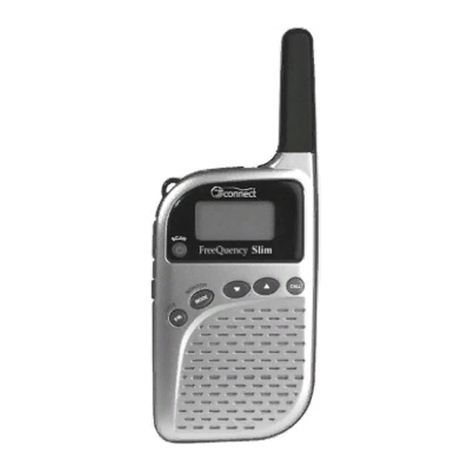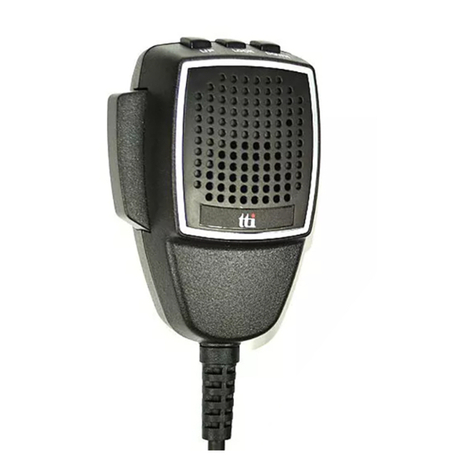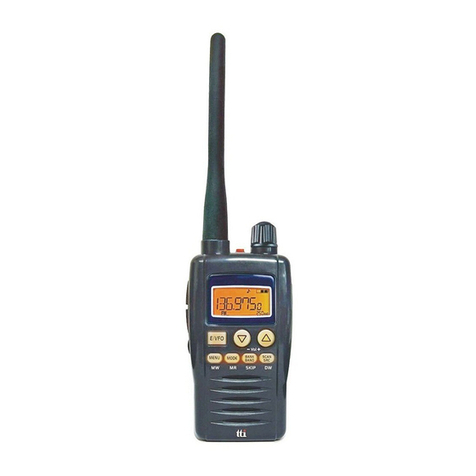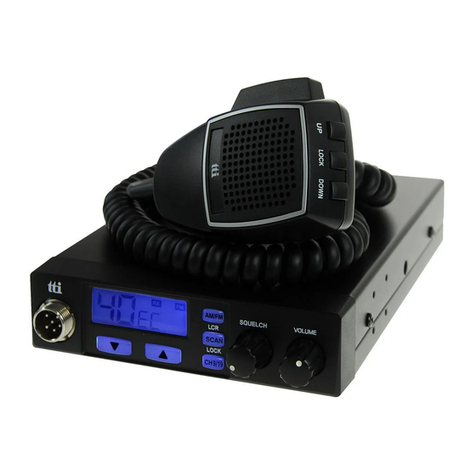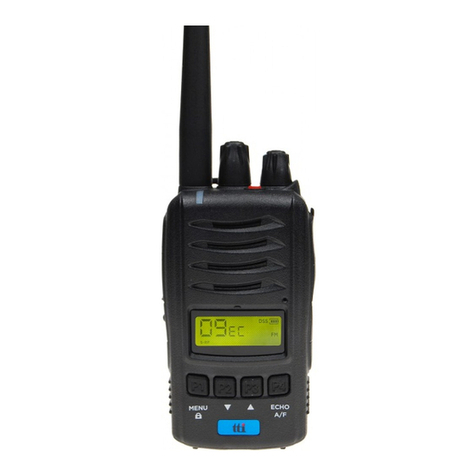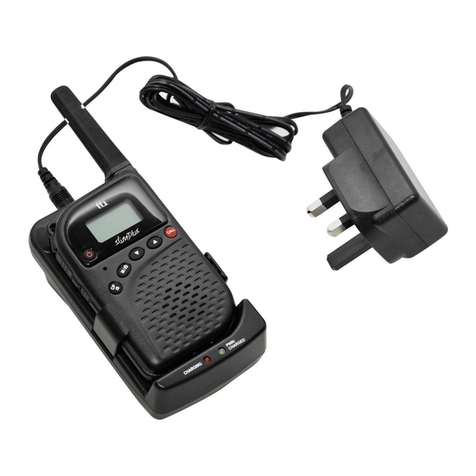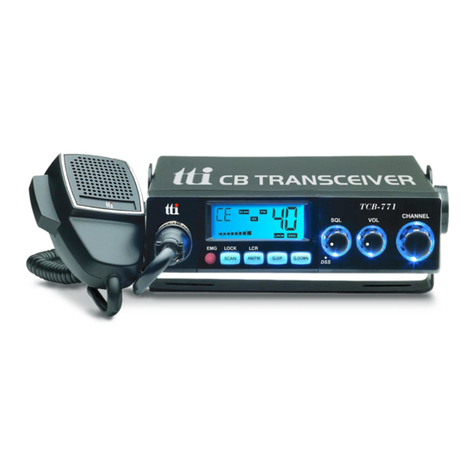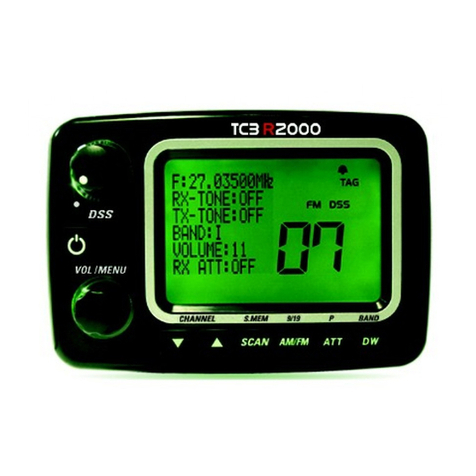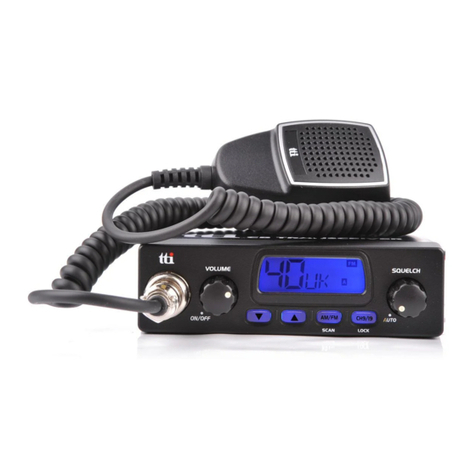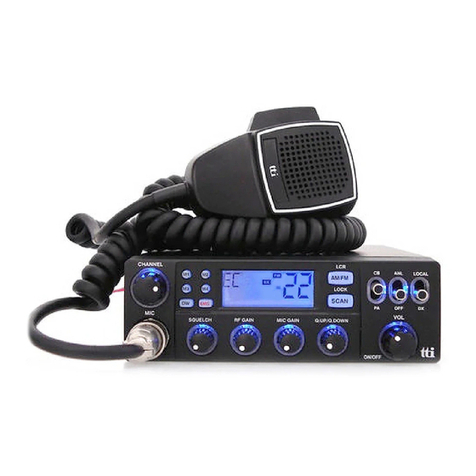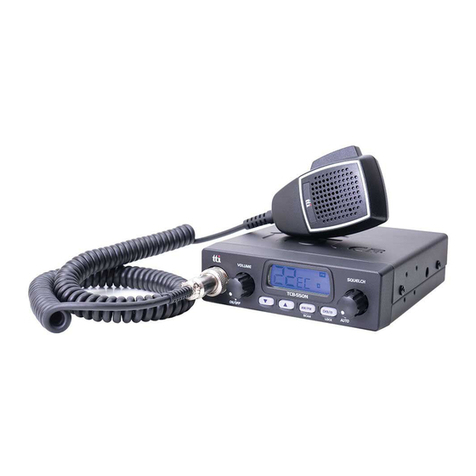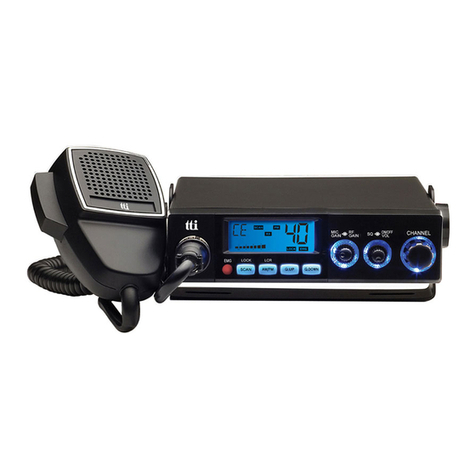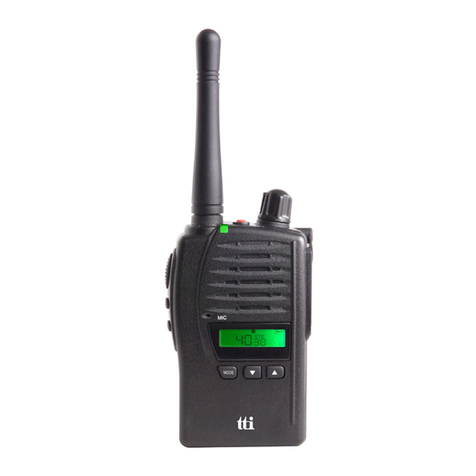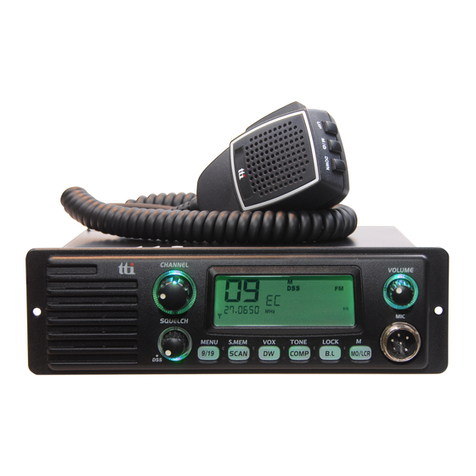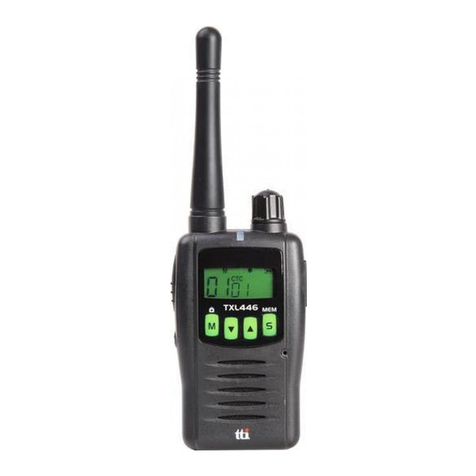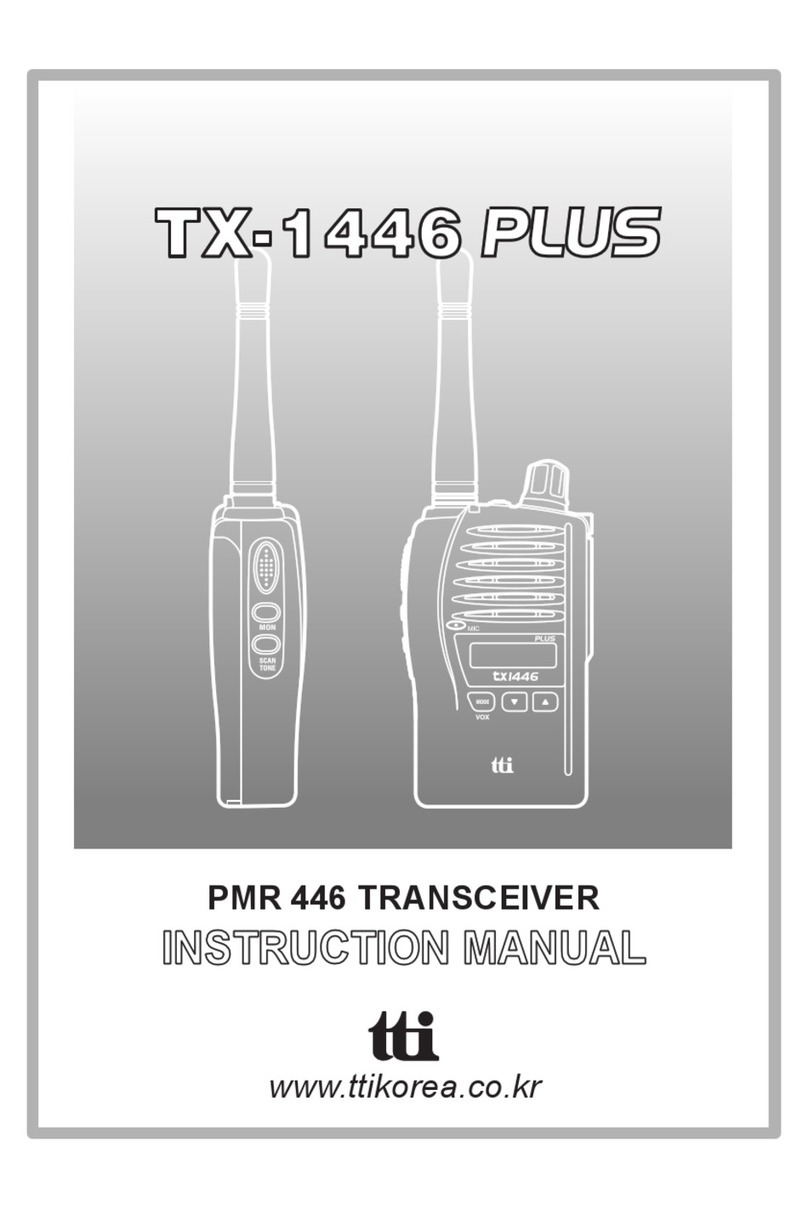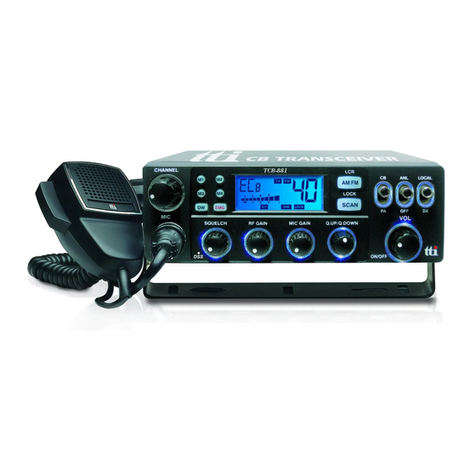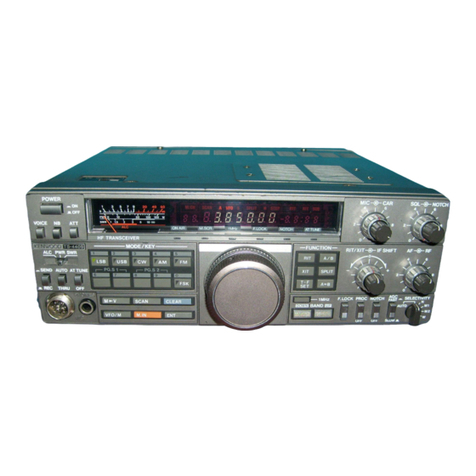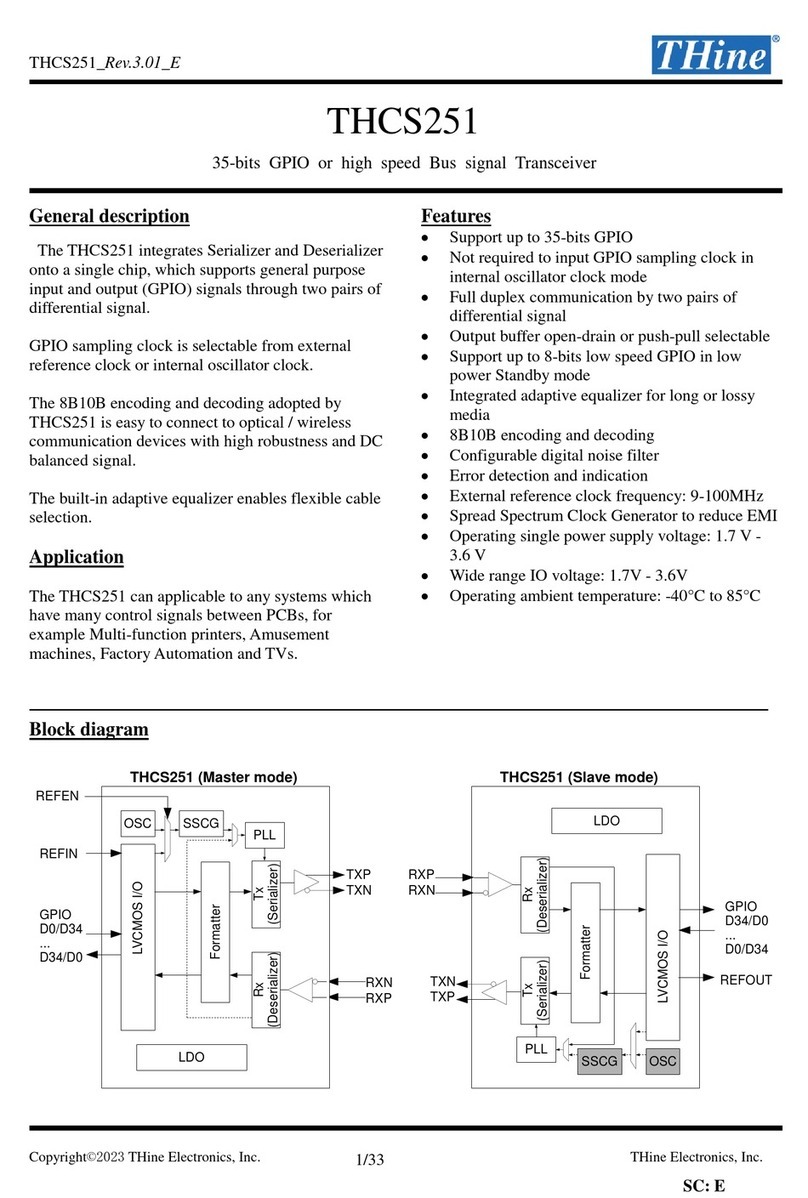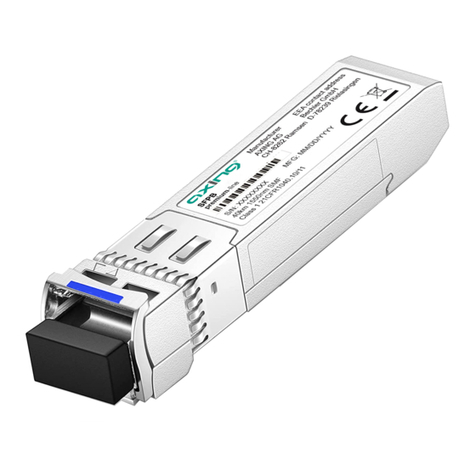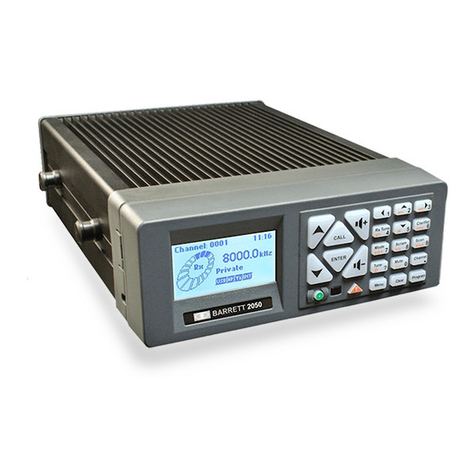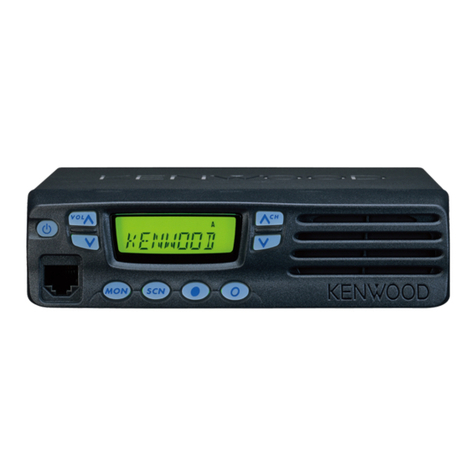TTI Freequency TCB-880 User manual

SERVICE
MANUAL
MULTI CHANNEL AM/FM TRANSCEIVER
TCB-880
TTI Tech
Downloaded from www.cbradio.nl

SECTION 1 SPECIFICATIONS
SECTION 2 CIRCUIT DESCRIPTION
1 GENERAL
2 TECHNICAL DESCRIPTION
3 SEMICONDUCTORS AND FUNCTION
4 DESCRIPTION OF FREQUENCY DETERMINING AND STABILIZING CIRCUIT
5 TEST EQUIPMENT SETUP AND ALIGNMENT INSTRUCTIONS
SECTION
5-3 LED PCB
3 PART LIST
SECTION
5-1 MAIN PCB
5-2
5-4 VOLUME PCB
5-5 MIC PCB
FRONT PCB
4 MECHANICAL DISASSEMBLY
SECTION 5 BOARD LAYOUT
SECTION 6 BLOCK DIAGRAM
SECTION 7 SCHEMATIC
TABLE OF CONTENTS

SECTION1 SPECIFICATIONS
Channel
Frequency Range
Operating mode
Frequency Control
Frequency Tolerance
Operating Temperature Range
Microphone
Input Voltage
Size
Weight
Antenna Connector
Power Output
Modulation
Frequency Response
Output Impedance
Harmonic Suppression
Current Drain
Receiving System
IF Frequencies
Sensitivity
Audio Output Power
Audio Distortion
Image Rejection
Adjacent Channel Rejection
Conducted Spurious
Frequency Response
Built-in Speaker
Squelch
* Specification is subject to change without prior notice.
T
R
A
N
S
M
I
T
T
E
R
R
E
C
E
I
V
E
R
G
E
N
E
R
A
L
40 (See the frequency band chart)
26.96 MHz ~ 27.99125 MHz
F3E (FM), A3E (AM)
PLL Synthersizer
0.002%
-10 to + 55 C
Plug-in Type
13.2V DC ± 15%
156 (W) x 176 (L) x 51(H)
990 g
SO-239 type
Duty cycle 10% 4 Watts @13.8V DC
AM:from 85% to 95%
FM:1.8KHz ± 0.2KHz
300Hz to 3000Hz
50ohms, Unbalanced
More than -36dBm
AM Full Mod. 1.6A Max.
Dual conversion superheterodyne
Double Conversion 1st 10.695MHz/2nd 455KHz
0.7 V for 10dB(S+N)/N
in AM Mode
0.5 V for 20dB SINAD in FM Mode
2.0W @ 8 Ohm
Less then 8% @ 1KHz
60 dB
60 dB
More than 60 dB
300 to 2500Hz
8 Ohms, round
Adjustable; Threshold less than 1 microvolt

------------ Contents -------------
1General
1-1. Receiver
1.2. Transmitter
2. Technical Description
2-1. General
2-2. Type of emission
2-3. Frequency Table
2-4. RF Power Output
2-5. DC input Voltage and Current with 13.2V DC Input to Power AMP
2-6. Receiver IF and Local Oscillator Frequencies
3. Semiconductors and Function
4. Description of Frequency Determining and Stabilizing Circuit
4-1. Introduction
4-2. Basic Synthesis Scheme
4-3. Descriptions of Each Block
4-3-1. Introduction
4-3-2. Reference Frequency
4-3-3. VCO
4-3-4. Programmable Divider and its Control
4-3-5 Phase Detector and VCO Control
4-3-6. Transmitter / Receiver Buffer AMP
4-3-7. Transmitter Doublers
4-3-8. Switching of Turning Capacitor in VCO
4-3-9. Receiver Local Oscillator Outputs
4-4. Frequency Stability
4-5. Description of other Circuits
4-5-1. Transmitter
4-5-2. Receiver
5. Test Equipment Setup and Alignment Instructions
5-1. General Section
5-2. Transmitter Section
5-3. Receiver Section
SECTION2CIRCUIT DESCRIPTION

1. General
1-1. Receiver
①Display : 40 Channels and other functions indication
②Frequency Range : 26.965 to 27.405 [MHz]
③Frequency Response : 300 to 2,500 [Hz]
④Power Source : 13.2 [V] DC
⑤Audio Output Load : 8 [OHM]
⑥Audio Output : 4.0 [W] (or More)
⑦Squelch : Adjustable from 0.3[uV] to 100 [uV]
⑧Sensitivity :
-FM : 20 dB [SINAD] under 1.0 [uV] RF Signal or less
-AM :10 dB [S/N] under 1.0 [uV] RF Signal or less
⑨Intermediate Frequency :
-1st IF : 10.695 [MHz]
-2nd IF : 455 [KHz]
1-2. Transmitter
①Carrier Power(Conducted) : AM 1 [W] / FM 4 [W]
②Current Drain ( 13.2 [V] Supply Voltage)
-No Modulation : 1,000 [mA]
-Max Modulation : 1,400 [mA]
③Modulation Capabilities
-AM : ±90 [%]
-FM : ±1.8 [KHz/Dev]
④Spurious Radiation : Less then 74 [dBc]
⑤Antenna Impedance : 50 [OHM]
⑥Frequency Tolerance : 0.002 [%]

2. Technical Description
2-1. General
Model CB-880 is an mobile type AM/FM radio transceiver for use of the Citizen Radio Service.
zFront Panel Controls
①LCD (Cannel and RX/TX Signal Level Indicator).
②Receiver Audio Control (With Power ON/OFF Control) Volume
③Squelch Control Volume
④RF Gain Control Volume
⑤MIC GAIN Control Volume
⑥CHANNEL UP/DOWN Rotary Switch
⑦Q.CHANNEL UP/DOWN Rotary Switch
⑧Memory(M1, M2, M3, M4) Key
⑨DW(Dual Watch) Key
⑩EMG(Emergency Channel Select) Key
⑪AM/FM Select Key
⑫Scan Key
⑬CB/PA Slide Switch
⑭ANL/OFF Slide Switch
⑮LOCAL/DX Slide Switch
zAccessorily Connectors
①Antenna Socket
②External Speaker Jack
③External PA Jack
④External Signal Meter Jack
⑤Microphone(Condenser Microphone)
2-2. Type of emission : AM(A3E) , FM(F3E)

2-3. Frequency Table
Channel Frequency (MHz) Channel Frequency (MHz)
1 26.965 21 27.215
2 26.975 22 27.225
3 26.985 23 27.235
4 27.005 24 27.245
5 27.015 25 27.255
6 27.025 26 27.265
7 27.035 27 27.275
8 27.055 28 27.285
9 27.065 29 27.295
10 27.075 30 27.305
11 27.085 31 27.315
12 27.105 32 27.325
13 27.115 33 27.335
14 27.125 34 27.345
15 27.135 35 27.355
16 27.155 36 27.365
17 27.165 37 27.375
18 27.175 38 27.385
19 27.185 39 27.395
20 27.205 40 27.405
2-4. RF Power Output
zAM : 1.0 [W]
zFM : 4.0 [W]
2-5. DC Iinput Voltage and Current with 13.2V DC Input to Power AMP
zTransmitter Power Amp : Voltage 12.5 V
Current 727 mA
zTransmitter Driver Amp : Voltage 12.5 V
Current 120 mA
2-6. Receiver IF and Local Oscillator Frequencies
zFirst IF : 10.695 [MHz]
zSecond IF : 455 [KHz]
zFirst Local Oscillator : 10.695 [MHz] Below Receiving Frequency
zSecond Local Oscillation : 10.240 [MHz]

3. Semiconductors and Function
3-1. Transistor
--------------------------------------------------------------------------------------------------------------------------------------------
Ref No. Description Manufacturer Function
--------------------------------------------------------------------------------------------------------------------------------------------
Q101 KTC3880S KEC RX Amplifier
Q102 KTK211 KEC 1’st Mixer
Q103 KTK211 KEC 1’st Mixer
Q104 KRC101S KEC RX Band1 Switching
Q105 KRC101S KEC RX Band2 Switching
Q121 KRC110S KEC
Q122 KRC112S KEC RX RSSI Level Control
Q131 KTC3875S KEC Squelch
Q151 KTC3875S KEC RX FM AF Amplifier
Q152 KRC112S KEC FM AF Mute at AM Mode
Q153 KRC101S KEC FM AF Mute at AM Mode
Q154 KRC112S KEC RX AF Mute at TX Mode
Q161 KTC3880S KEC AM IF Amplifier
Q162 KTC3880S KEC AM IF Amplifier
Q163 KRA102S KEC RX AM B+
Q164 KTA1504S KEC Automatic Noise Level Control
Q181 KTC3875S KEC RX RF Mute at TX Mode
Q182 KTC3875S KEC AGC
Q183 KTC3875S KEC AGC
Q201 KRC101S KEC AF Mute
Q202 KRC202S KEC AF Path
Q233 KTA1504S KEC Automatic Level Control
Q234 KTC3875S KEC Automatic Level Control
Q301 KTC3880S KEC VCO
Q302 KTC3880S KEC RX/TX VCO Buffer
Q303 KTC3880S KEC VCO Buffer
Q305 KRC101S KEC TX VCO Control
Q311 KRC101S KEC RX Band1 Switching
Q312 KRC101S KEC RX Band2 Switching
Q313 KRC101S KEC RX Band3 Switching
Q502 KTC3875S KEC FM TX AF Mute at AM TX
Q701 KTC3880S KEC TX Doublers
Q702 KTC3880S KEC TX Pre-Amplifier
Q703 KTC1006 KEC TX Driver Amplifier
Q704 2SC2078 SANYO TX Power Amplifier
Q742 KTC3875S KEC TX RF Mute at RX Mode
Q801 KRC101S KEC CPU Reset
Q802 KRC101S KEC CPU RX/TX Control
Q803 KRA101S KEC MIC Lock Control
Q911 KTA1658 KEC Main Regulator
Q912 KRA1504S KEC Main Regulator
Q913 KRC112S KEC Main Regulator Control
Q914 KRC102S KEC Power Low Control
Q921 KTC3875S KEC 8.2V Regulator
Q922 KRC112S KEC 8.2V Regulator Mute at PA Mode
Q923 KTC3875S KEC RX B+
Q924 KRA1504S KEC TX B+

Q941 KRC111S KEC Mute
Q942 KRC112S KEC TX B+ Mute at TX Mode
Q951 KTA1241 KEC Back Light LED Control
Q952 KTA1241 KEC Back Light LED Control
Q953 KRC101S KEC Back Light LED Control
Q954 KRC101S KEC Back Light LED Control
Q961 KRC110S KEC TX AF Mute at RX Mode
Q962 KRC111S KEC MIC AF Path at AM Mode
Q963 KRC111S KEC MIC AF Path at PA Mode
3-2. IC
--------------------------------------------------------------------------------------------------------------------------------------------
Ref No. Description Manufacturer Function
--------------------------------------------------------------------------------------------------------------------------------------------
IC101 TK144889V TOKO IF IC
IC102 KIA358F KEC AGC, Squelch Control
IC201 KIA7217AP KEC AF Power Amplifier
IC301 LC7152NM SANYO PLL
IC401 KIA4558F KEC FM TX AF
IC801 TMP87PP21DF TOSHIBA CPU
IC802 24WC02 ATMEL EEPROM
3-3. Manufacture Information
zKEC ---------------------- KEC Co., LTD.
zSANYO ---------------------- SANYO Semiconductor Co., LTD.
zTOKO ---------------------- TOKO, Inc.
zTOSHIBA ---------------------- Toshiba Semiconductor. Co., LTD.
zATMEL ---------------------- ATMEL Co., LTD

4. Description of Frequency Determining and Stabilizing Circuit
4-1. Introduction
The Frequencies for transmitter and receiver first local frequencies are all derived from a signal
4.5MHz crystal by means of a phase locked loop(PLL).
The first local oscillator frequencies are 16.270MHz(CH1) to 16.710MHz(CH40). The second local
frequency is fixed at 10.240MHz to generate second IF 455KHz.
Transmit, the VCO of the PLL operates 13.4825MHz(CH1) to 13.7025MHz(40CH). The VCO frequency
goes to the doublers circuit Q701, L701, L702 with doubles the frequency to generate 26.965MHz(CH1)
to 27.405MHz(40CH).
Q302
VCO Q701
Doublers
13.4825MHz(CH1)
~
13.7025MHz(CH40)
26.965MHz(CH1)
~
27.405MHz(CH40)
To transmitter
The VCO operating frequency for the receiver is 16.27MHz(CH1) to 16.710MHz(CH40) as the
first local oscillator, injected through the buffer amplifier Q302 into the first FET balanced mixer Q102,
Q103.
4-2. Basic Synthesis Scheme
The crystal frequency(4.5MHz) is divided by 1800 times to make 2.5KHz which is fed to one
side of the phase detector. The VCO output is divided by a programmable divider, and fed to other side of
the phase detector Pin 9, 10 of IC301. Passing the phase detector output closes the feedback loop through
an active low pass filter and using the output to control the VCO frequency through varicap diode D301.
Under locked conditions, both of phase detector input signal must be identical at 2.5KHz.
The VCO frequency is then given by ;
Receiver : Fvco / N = 0.005 [MHz] OR Fvco = 0.005 X N [MHz]
Transmitter : Fvco / N = 0.0025 [MHz] OR Fvco = 0.0025 X N [MHz]
Since “N” is an integer, the VCO frequency can be stepped up with in receiver mode 5KHz and
transmitter mode 2.5KHz increments.
By suitable choice of “N” the desired output frequency can be obtained.
Channel 1 Channel 40
N Fvco N Fvco
Transmit 5393 13.4825 5481 13.7025
Receiver 3254 16.2700 3342 16.7100
See the [Table 1]for other Channels
The VCO frequency goes to the doublers circuit, with doubles the incoming signals.
VCO Output Frequency Doublers Output Frequency

Transmit
---
---
---
Transmit
CH 1 , 13.4825 MHz
CH 40 , 13.7025 MHz
26.965 MHz
27.405 MHz
Since all frequencies are obtained from the crystal controlled PLL oscillator, all outputs are
coherent with the crystal oscillator frequency and matching the sample percentage accuracy.
Note that the reference frequency of 5KHz(receiver) and 2.5KHz(transmitter) is obtained by
dividing the 4.5MHz by 900 times and 1800 times
See Table 1 for transmitter/receiver mode VCO frequencies.

Program Data & Frequency[Table 1]
RX TX
Channel Frequency
[MHz] N Fvco N Fvco
1 26.965 3254 16.27
5393 13.4825
2 26.975 3256 16.28
5395 13.4875
3 26.985 3258 16.29
5397 13.4925
4 27.005 3262 16.31
5401 13.5025
5 27.015 3264 16.32
5403 13.5075
6 27.025 3266 16.33
5405 13.5125
7 27.035 3268 16.34
5407 13.5175
8 27.055 3272 16.36
5411 13.5275
9 27.065 3274 16.37
5413 13.5325
10 27.075 3276 16.38
5415 13.5375
11 27.085 3278 16.39
5417 13.5425
12 27.105 3282 16.41
5421 13.5525
13 27.115 3284 16.42
5423 13.5575
14 27.125 3286 16.43
5425 13.5625
15 27.135 3288 16.44
5427 13.5675
16 27.155 3292 16.46
5431 13.5775
17 27.165 3294 16.47
5433 13.5825
18 27.175 3296 16.48
5435 13.5875
19 27.185 3298 16.49
5437 13.5925
20 27.205 3302 16.51
5441 13.6025
21 27.215 3304 16.52
5443 13.6075
22 27.225 3306 16.53
5445 13.6125
23 27.255 3312 16.56
5451 13.6275
24 27.235 3308 16.54
5447 13.6175
25 27.245 3310 16.55
5449 13.6225
26 27.265 3314 16.57
5453 13.6325
27 27.275 3316 16.58
5455 13.6375
28 27.285 3318 16.59
5457 13.6425
29 27.295 3320 16.60
5459 13.6475
30 27.305 3322 16.61
5461 13.6525
31 27.315 3324 16.62
5463 13.6575
32 27.325 3326 16.63
5465 13.6625
33 27.335 3328 16.64
5467 13.6675
34 27.345 3330 16.65
5469 13.6725
35 27.355 3332 16.66
5471 13.6775
36 27.365 3334 16.67
5473 13.6825
37 27.375 3336 16.68
5475 13.6875
38 27.385 3338 16.69
5477 13.6925
39 27.395 3340 16.70
5479 13.6975
40 27.405 3342 16.71
5481 13.7025

4-3. Descriptions of Each Block
4-3-1. Introduction
The synthesizer is implemented with the following components;
PLL IC (IC301)
X-TAL (X301)
VCO, VARICAP DIODE (D301)
IC1301 is CMOS LSI that includes most of PLL block.
The Q301, L301, C311, C312, C313, C314, varicap diode D301 are clap oscillator circuit to
operate as a VCO of the IC301. Q305 is a switching transistor to connect or disconnect the tuning
capacitor in the VCO oscillator tank circuit for transmitter or receiver.
Q302 works as a buffer amplifier for RX local frequencies (≒16MHz) and TX carrier
generating frequencies(≒13MHz)
4-3-2. Reference Frequency
The crystal X301(4.5MHz) and other components at Pin 1 and 24 of IC301 can make a reference
frequency oscillator with internal amplifier.
4-3-3. VCO
Q301 and surrounding parts are consisting a clap oscillator works as a VCO of IC301. With
appropriate control voltage on D301 the VCO can be oscillate over the required range of 13.4825MHz to
16.710MHz.
4-3-4. Programmable Divider and its Control
The programmable input for each channel are stetted by the PLL Clock(Pin 11), PLL Data(Pin
12), PLL Enable(Pin 13) of IC801. Each input signal to control the PLL ic is done with provide key input
Pin 18, 19, 25, 26, 27, 28, 29, 32, 33, 34, 35, 37. For each key input, an internal code converts EEPROM
appropriate control to the programmable divider for that channel.
Since the change transmit and receive, and additional bit is required at Pin 8 of IC801 to allow
the ROM to recognize the status TX or RX.
During transmit the push to talk switch makes Pin 8 ground with BRT(Q802), PLL IC works
under transmit status.
The programmable divider output fed to the phase detector for compare with the 2,5KHz
reference frequency IC301. See table 1 for actual input and divide ratio on all channels.
4-3-5. Phase Detector and VCO Control
The phase detector is a digital phase comparator witch compares the phase of the reference
signal with programmable divider output square waves and develops a series of pulses whose dc level
depends on the phase error of each signal.
The phase detector pulse output is fed to an active low pass filter and RC low pass filter output
signal of IC301 is filtered and fed to varicap D301 control the VCO frequency.
4-3-6. Transmitter / Receiver Buffer AMP
Output signal of Q301 is fed into the buffer amplifier Q302, L302 to generate TX carrier
frequency and 1’st local frequencies.

4-3-7. Transmitter Doublers
The output signal of Q302, L302 goes to an amplifier with tuning circuit Q701, L701, L702
which doubles incoming 13MHz signals.
4-3-8. Switching of Turning Capacitor in VCO
The VCO circuit must tune with a wide range of frequencies 13.4825MHz ~ 13.7025MHz for
transmitter and 16.27MHz ~16.71MHz for receiver.
To comply above range of VCO, the tuning capacitance should switch for transmission. The
tuning circuit consists with L301, C311, C312, C313, and C314. When the VCO is working as a receiver
Q305 becomes turn OFF. So, L301 and C311, D301 makes turning function.
When transmitting, Q305 becomes ON. S the o, L301 an parallel capacitance of C316 and C311
make turning function.
4-3-9. Receiver Local Oscillator Outputs
zFIRST MIXER :
The secondary output signal of L107 is injected to the sources of 1’st mixer Q102, Q103 in the
1’st IF mixer section.
zSECOND MIXER :
The output of 10.24MHz oscillator circuit with X101 is injected into the IF IC(IC101) internally.
Incoming IF signal and 10.24MHz signal are mixed inside the IF IC to extract 2’nd IF signal 455KHz.
FM audio Signals are recovered with the way of quadrature detector.
AM signals are recovered with envelope detector.
4-4. Frequency Stability
Let : Fo = Crystal oscillator frequency
Fr = Phase detector reference frequency
Fvco = VCO frequency
Ft = Transmit frequency
Then : Receiver : Fr = Fo/900
Transmitter : Fr = Fo/1800
And under locked conditions : Fr = Fvco / N
Where, “N” is the programmable divider divide ratio.
Then : Fvco = N X Fr)
From which it can be seen, the percentage error in Ft is the same as the percentage error in Fo.
The stability of the crystal oscillator is determined primarily by the crystal itself and having lesser
deviation by the active and passive components of the oscillator. The choice of crystal and components is
such that the required frequency stability is maintained over the required voltage and temperature range.

4-5. Description of other Circuits
4-5-1. Transmitter
A. RF Amplification
RF carrier frequencies are obtained at the output of doublers amplifier Q701 and turning IFT coil
L701, L702. The input of VCO frequencies 13MHz is selected at the doublers output, which creates the
necessary 27MHz. The output of doublers amplifier Q701 is fed through turning IFT coil L701, L702 to
the base of pre driver amplifier Q702. It’s output; 27MHz is coupled to RF driver amplifier Q703, a low-
level class C power amplifier. Driver Q703 supplies the necessary power gain to operate RF final Q704 at
the maximum efficient. The output of Q704 is supplied to the antenna through L-C turning circuit.
B. Circuit for Suppression of Spurious Radiation
The turning circuit between the output of final amplifier Q704 and antenna, 4-stage “π”
network C722, C723, C724, L711, C725, C726, L712, C729, C731, L732, C732, C733, C734, L714,
C735 serves as a spurious radiation suppressor. This network also servers to match the impedance
between TX power amplifier Q704 and the antenna.
C. Circuits for Limiting Power
After finished all alignment, the constant voltage supply circuit limits the available power 4W or
slightly less. RV911 and corresponding three-transistor control supply voltage of RF power amplifier.
When power low switch function Q914 changed the supply voltage. Tune all the trimming parts for
maximum indication of RF power meter and adjust RV571 to make 4W indication of RF power meter.
After finishing the above adjustments check the RF power meter reading is changed 1W under “LOW”
state.
The turning is adjustment so that the actual power is from 3.8W to 4.0W. There are no other
additional controls for adjusting the TX output power.
D. Modulation Control
Modulation of the RF is a process that begins with the audio picked up by the microphone.
<FM>
The microphone input is fed to mic audio amplifier IC401 that drives modulation vricap diode
D302 in the VCO circuit RV401 limits the incoming modulation audio levels to inhibit over modulation.
While reading the modulation factor on the modulation analyzing equipment, adjustment RV401 shall not
exceed 2.0KHz deviation.
<AM>
Modulation signals are filtered with RC network and goes to the audio power amplifier IC201 in
to make normal signal level to achieve wanted modulation. IC201 drives T201, which is a combination
AF output/modulation transformer. During transmit, one of the secondary windings of T201 is tied
between the 13.2V DC supply and the collectors of RF driver Q703 and RF power amplifier Q704. As the
audio passes through T201 it causes the collector supplies of Q703 and Q704 to vary with audio,
producing an AM signal at carrier frequency.
To avoid over modulation of the carrier, a protection of the modulating signal is fed back from
the T201 through the AMC circuit, Q233 and Q234, to control the gain of IC201 and sets the maximum
level of modulation. Form the center tab of RV231 and Q233 the feedback signal is rectified by diode
D233, filtered by C233, and supplied the Q234. The collector of Q234 is tied directly TX audio input to
control gain. That is, when the audio output is higher that the preset level of RV231, the information is
reflected through Q233 and Q234, reducing the gain of IC201

4-5-2. Receiver
Overload protection is provided to receiver’s semiconductors by diode D101. These diodes have
a little effect on the incoming signal from another CB station; they protect the receiver from stray
transmitter energy.
In the receiver mode of operation, Q923 transistor is turned on. Also bias voltage is applied to
Q101, Q102, Q103, Q106.
Q101 is a 27MHz RF input amplifier, and any excessive input signal is limited by diode D101.
CB receiver is dual conversion super-heterodyne type with the first IF 10.695MHz and the
second IF 455KHz.
Receiver is separated to blocks, 1’st IF section and 2’nd IF section. The PLL synthesizer
supplies 1’st local frequency 16.270MHz ~ 16.710MHz. The amplified 27MHz is mixed. With the
provide 1’st local frequencies Q102, Q103 mixes the incoming RF signal to generate 1’st IF signal. The
resulting first IF is 10.695MHz. Q102 and Q103 is the first converter, and 10.695MHz is sharply filtered
by L108 and crystal filter CF101. The first IF is again mixed with a second local oscillator of 10.24MHz.
With the 10.240MHz signal, IC101 FM IF IC converts the incoming signals to generate 2’nd IF
signal and recovered audio signals. 2’nd IF is filtered by a razor sharp ceramic filter CF101 coupled. The
455KHz signal from the 2’nd IF filter was amplified and limits internally. After amplification the signals
fed to the quardrature detector loop L109. Then could see the recovered signals Pin 11 of IC101.
With the amplitude of recovered signals, Q151 serves as an amplifier.
AM signals from the Pin 6 of IC101 were tapped with C161 and amplified two-stage amplifier
Q161, Q162. Q161 is a first 455KHz amplifier, and the Q161 being the last amplifier. D106 is a detector
diode witch produce audio signal as well as negative DC voltage for AGC action. The negative voltage
also provides forward biasing to the emitter of ANL clipping transistor Q164. The biasing voltage has a
time constant determined R174 and C176. Therefore any sharp negative going pulse from D161 will back
bias Q164 and clipped. The way to recover the AM information audio is envelope detector.

5. Test Equipment Setup and Alignment Instructions
5-1 General Section
5-1-1 Test Equipment Required
•DC power supply(13.8V/3A)
•DC Voltmeter or Oscilloscope
•RF attenuator (30dB)
5-1-2 Alignment Procedure
Step Setting Connection Adjuster Adjust for
1 RX VCO voltage Adj.
Channel & Frequency :
1CH, 26.956 MHz
Mic : Receive
Volume : Optional
Squelch : Optional
RF Gain : Optional
Mic Gain : Optional
DC voltmeter to VCO
Test point (Figure 1) L301 1.5~2.0 V DC
2 TX VCO voltage Adj.
Channel & Frequency :
1CH, 26.956 MHz
Mic : Transmit(No Mod)
Volume : Optional
Squelch : Optional
RF Gain : Optional
Mic Gain : Optional
DC voltmeter to VCO
Test point (Figure 1) L301 1.5~2.0 V DC
Figure 1

5-2 Transmitter Section
5-2-1 Test Equipment Required
•RF Power Meter •DC power supply(13.8V/3A)
•50 ohms load (non-inductive) •Spectrum analyzer
•RF attenuator (30dB) •Frequency counter
•Oscilloscope •Coupler
•Audio generator •Modulation meter
5-2-2 Alignment Procedure
Step Setting Connection Adjuster Adjust for
1 RF Power Adj.
Channel : 19CH
Function : AM or FM Mode
CB/ANL Off/DX
MIC : Transmit
Volume : Optional
Squelch : Optional
RF Gain : Optional
MIC Gain : Minimum
Connect dummy load and RF
Power Meter to the EXT–ANT
connector on the set(Figure 3)
L302
L701
L702
L703
Maximum
indication on
the Power
Meter(4.0W).
If indication is
not in 4W
range, ACP
Adjustment(R
V911)
2 Frequency Adj.
Channel & Frequency :
19CH, 26.956 MHz
Function : AM or FM Mode
CB/ANL Off/DX
Mic : Transmit(No Mod)
Volume : Optional
Squelch : Optional
RF Gain : Optional
MIC Gain : Optional
Connect dummy load and
Frequency Counter through
Coupler to RF Power Meter.
Connect RF Power Meter to
EXT-ANT connector on the
set(Figure 2).
CT302 Be sure that
the indication
of the
transmitter
frequency is
27.185MHz
±300 Hz on
the Frequency
Counter
3 AM Modulation Adj.
Channel & Frequency :
19CH, 27.185MHz
MIC: Transmit
Function : AM Mode
CB/ANL Off/DX
Volume : Optional
Squelch : Optional
RF Gain : Optional
MIC Gain : Max
Connection the audio
generator (set to 1 KHz)to the
microphone.
Connect the modulation meter
through the RF attenuator to
the ANT Connector. Adjust
the audio signal level to obtain
by 50% modulation.
When you increase the audio
signal by 20 dB, the
modulation should not exceed
95% Modulation(Figure 3).
RV231 85% ~ 95%

4 FM Deviation Adj.
Channel & Frequency :
19CH, 27.185MHz
MIC : Transmit
Function : FM Mode
CB/ANL Off/DX
Volume : Optional
Squelch : Optional
RF Gain : Optional
MIC Gain : Max
Connection the audio
generator (set to 1 KHz)to the
microphone.
Connect the modulation meter
through the RF attenuator to
the ANT Connector. Adjust
the audio signal level to obtain
by 1KHz deviation.
When you increase the audio
signal by 20 dB, the deviation
should not exceed 2.0KHz
deviation(Figure 3).
RV401 1.8KHz ~
2.0KHz
5 TX Signal Meter Adj.
Channel & Frequency :
19CH, 27.185MHz
MIC : Transmit
Function : FM Mode
CB/ANL Off/DX
Volume : Optional
Squelch : Optional
RF Gain : Optional
MIC Gain : Minimum
Connected through Dummy
load to RF Power Meter.
Connect RF Power to EXT-
ANT connector on the
set(Figure 2)
RV571 Adjust for 4
watts RF
output power
on the signal
meter.
Figure 2
Figure 3

5-3 Receiver Section
5-3-1 Test Equipment Required
•Standard Signal Generator(SSG)
•DC power supply(13.8V/3A)
•AC Level Meter
•Distortion Meter
•Oscilloscope
•SINAD Meter
•8 ohm Dummy Load
5-3-2 Alignment Procedure
Step Setting Connection Adjuster Adjust for
1 AM Audio Output Adj.
Channel & Frequency :
19CH, 27.185MHz
MIC : Receive
Function : AM Mode
CB/ANL Off/DX
Volume : Full clockwise
Squelch : Turn to counter
clockwise
RF Gain : Full clockwise
Connect RF Signal Generator
to EXT-ANT Connector.
Connect AC Level Meter and
Distortion Meter and SINAD
Meter across EXT SPK jack
with 8 ohm Dummy
Load(Figure 4)
L101
L103
L104
L105
L107
L108
L112
Maximum
indication on
AC Level
Meter. Reduce
output from
SSG until the
audio output
becomes about
2V.
2 FM Audio Output Adj.
Channel & Frequency :
19CH, 27.185MHz
MIC : Receive
Function : FM Mode
CB/ANL Off/DX
Volume : Full clockwise
Squelch : Turn to counter
clockwise
RF Gain : Full clockwise
Connect RF Signal Generator
to EXT-ANT Connector.
Connect AC Level Meter and
Distortion Meter and SINAD
Meter across EXT SPK jack
with 8 ohm Dummy
Load(Figure 4)
L109 Maximum
indication on
AC Level
Meter. Reduce
output from
SSG until the
audio output
becomes about
2V.
3 Squelch Adj.
Channel & Frequency :
19CH, 27.185MHz
MIC : Receive
Function : FM Mode
CB/ANL Off/DX
SSG : 27.185MHz, 1KHz,
100uV, 1.5KHz Dev.
Volume : Full clockwise
Squelch : Full clockwise
clockwise
RF Gain : Full clockwise
Connect RF Signal Generator
to EXT-ANT Connector.
Connect AC Level Meter and
Distortion Meter and SINAD
Meter across EXT SPK jack
with 8 ohm Dummy
Load(Figure 5)
RV131 Adjust until
the audio
output
appears.
Other manuals for Freequency TCB-880
1
Table of contents
Other TTI Transceiver manuals
Popular Transceiver manuals by other brands
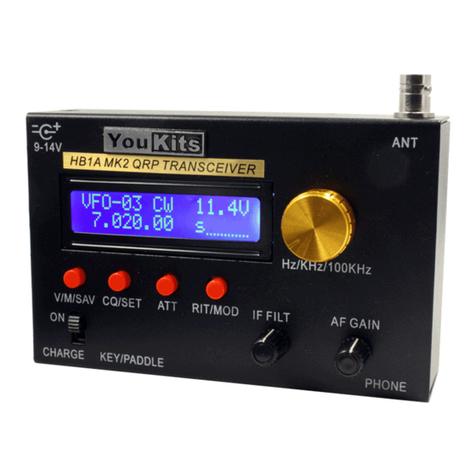
YouKits
YouKits HB-1A MK2 manual

Cabletron Systems
Cabletron Systems TRFOT-2 user guide
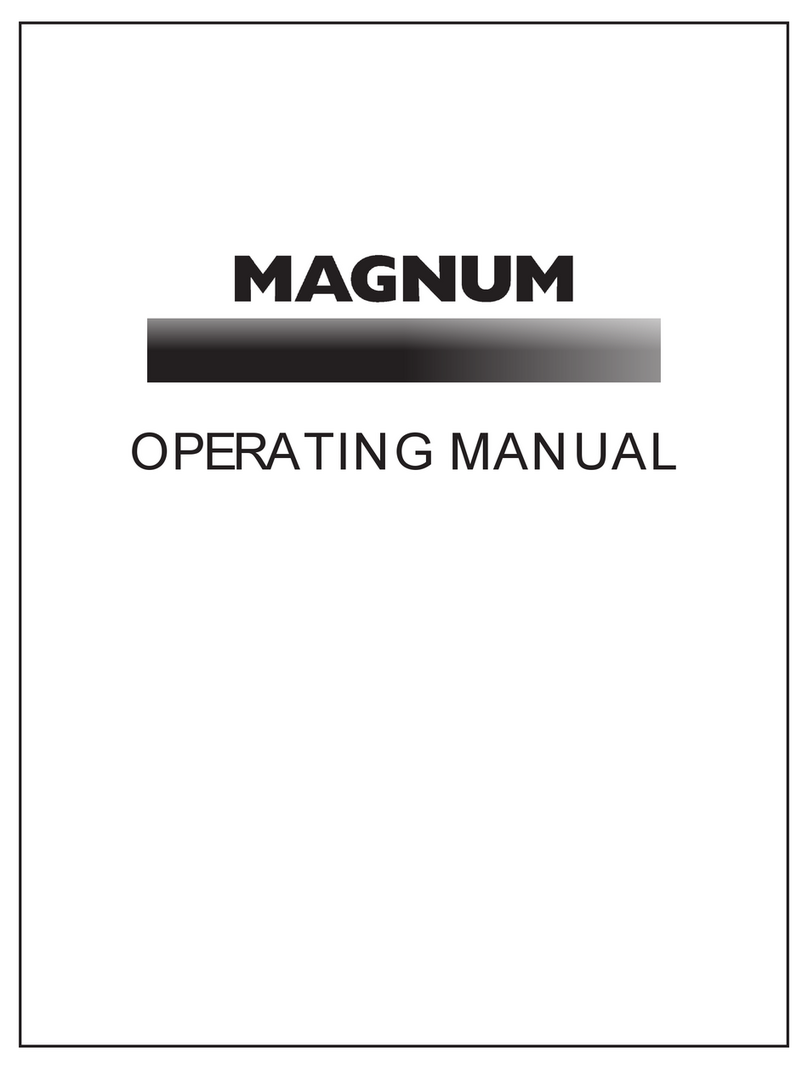
Magnum
Magnum Delta Force operating manual
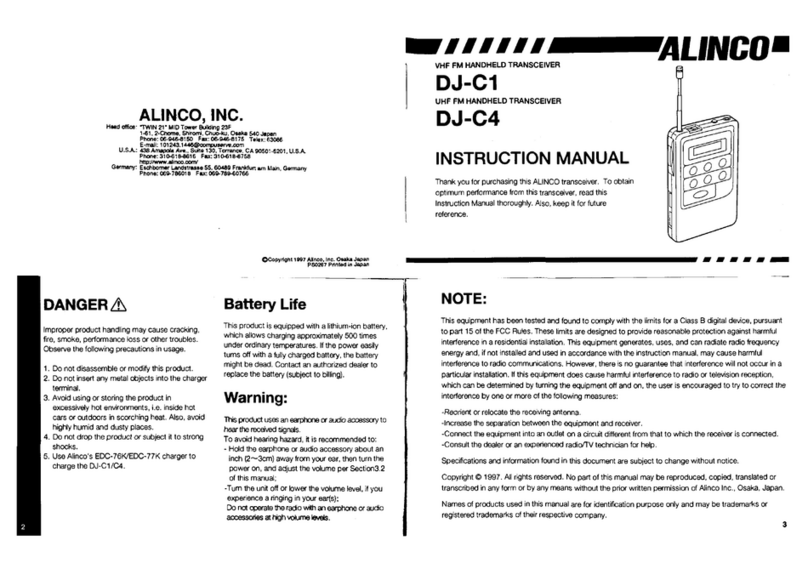
Alinco
Alinco DJ-C1 instruction manual
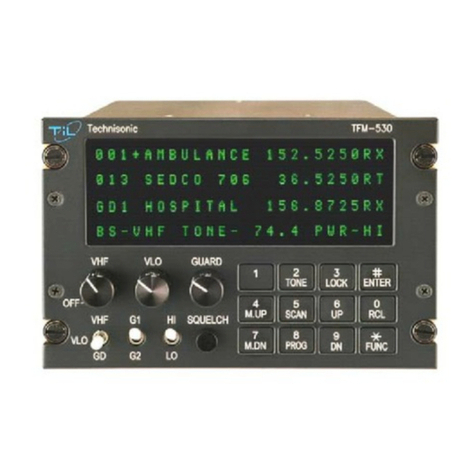
Technisonic Industries Limited
Technisonic Industries Limited TFM-530 Installation and operating instructions
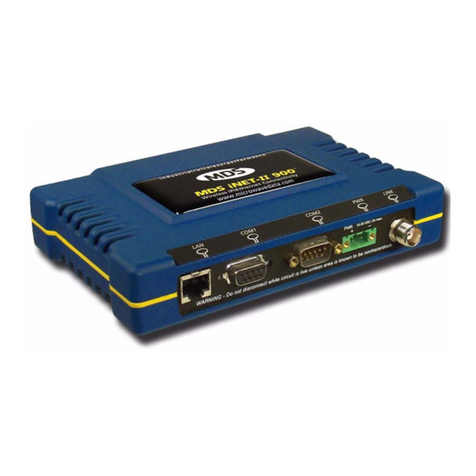
GE
GE MDS iNET Series Reference manual

Tait
Tait T2030II user guide
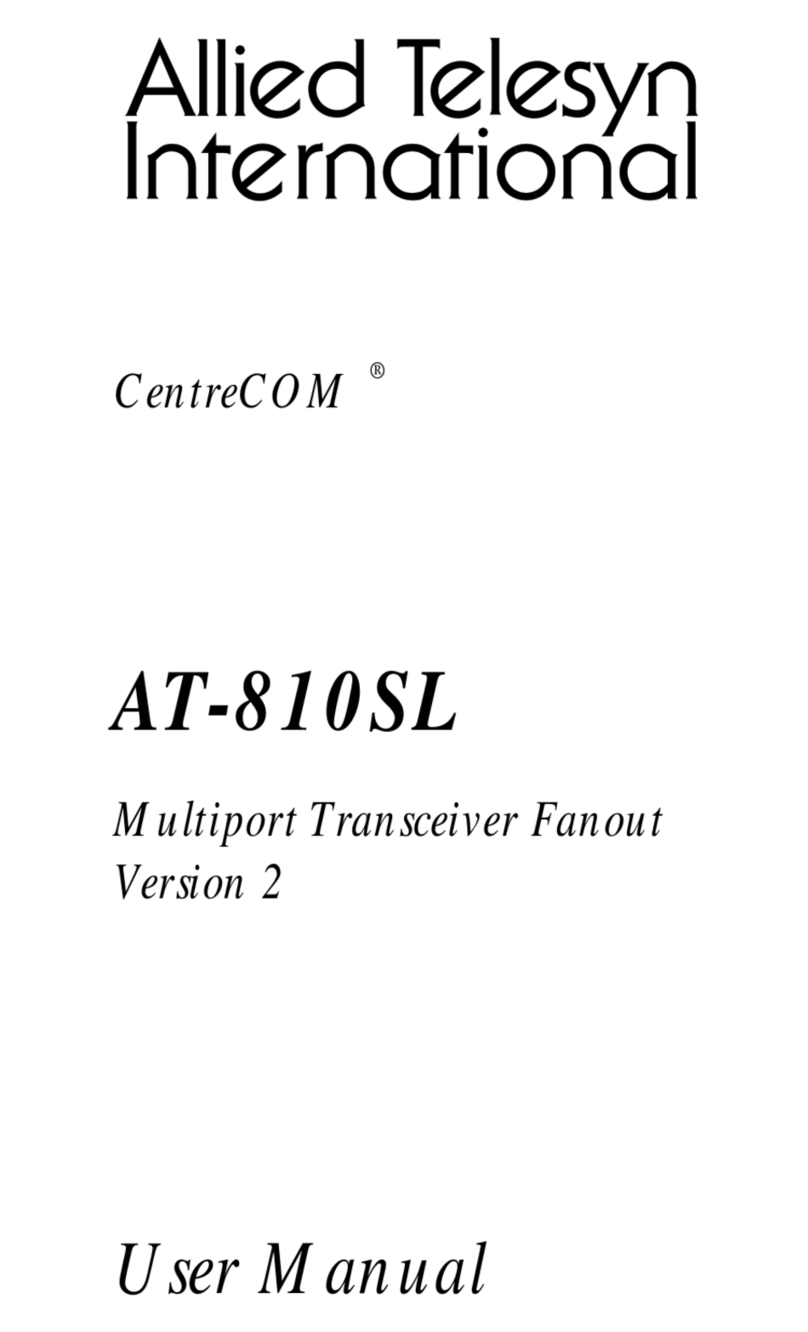
Allied Telesis
Allied Telesis CentreCOM AT-810SL user manual

Schweitzer Engineering Laboratories
Schweitzer Engineering Laboratories SEL-2890 instruction manual
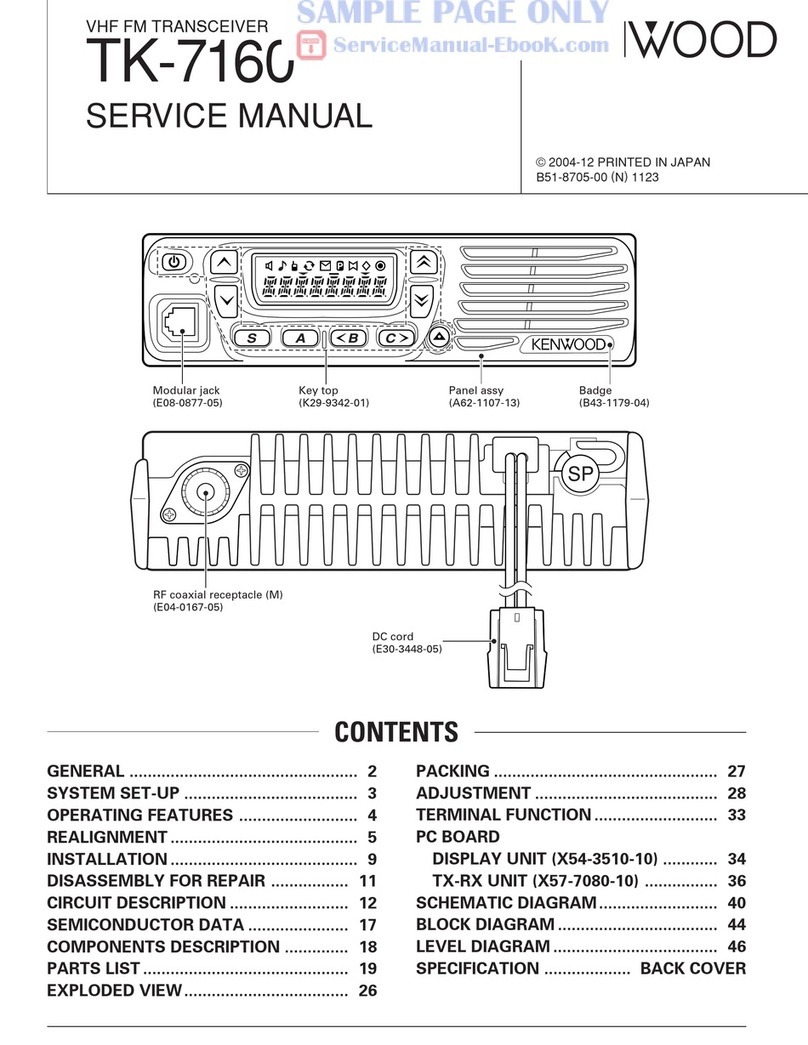
Kenwood
Kenwood TK-7160 Service manual

Ranger Communications
Ranger Communications RCI-5054DX owner's manual

Yaesu
Yaesu FT-101EX manual
